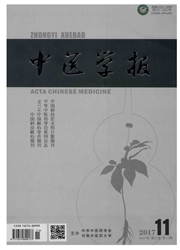

 中文摘要:
中文摘要:
目的:观察芝莲化癥不同组方对移植肝癌小鼠瘤体质量、抑瘤率、巨噬细胞吞噬率、吞噬指数、半数溶血值、淋巴细胞转化率水平的影响。方法:选择雄性8~10周龄健康清洁级C57小鼠50只,采用随机数字表法分为模型组、芝莲化癥药效组分组、芝莲化癥配方颗粒组、芝莲化癥膏方组、健康对照组各10只。除健康组外,各组小鼠腋下皮下接种肝癌Hepa 1-6瘤株。接种1周后给予芝莲化癥灌胃,连续治疗10 d。观察各项指标水平。结果:中药治疗各组较模型组瘤体质量明显下降,其中芝莲化癥配方颗粒组、芝莲化癥膏方组与模型组比较,差异有统计学意义(P〈0.05)。芝莲化癥膏方组抑瘤率(45.22±2.70)%较芝莲化癥药效组分组(35.22±2.46)%、芝莲化癥配方颗粒组(42.68±2.13)%升高,但组间比较,差异无统计学意义(P〉0.05)。中药治疗各组吞噬率、吞噬指数(0.60±0.03、0.63±0.04)较模型组明显提高,中药治疗各组与模型组(0.51±0.01)吞噬指数比较,差异有统计学意义(P〈0.05)。中药治疗各组半数溶血值较模型组均有升高,芝莲化癥膏方组与模型组(19.68±1.93 vs15.20±2.40)比较,差异有统计学意义(P〈0.05)。中药治疗各组淋巴细胞转化率均有升高,芝莲化癥配方颗粒组(40.61±3.50)%、芝莲化癥膏方组(41.22±3.61)%与模型组(25.06±1.60)%比较,差异有统计学意义(P〉0.05)。结论:芝莲化癥方药不同组方能调节巨噬细胞吞噬率、淋巴细胞转化率,抑瘤效果明显,尤其是芝莲化癥膏方具有显著的调节免疫功能抗肿瘤功效。
 英文摘要:
英文摘要:
Objective :To investigate effect of Zhilianhuazheng different prescriptions on tumor weight and inhibition rate, macropbage phagocytosis rate, phagocytic index, serum hemolysin, lymphocyte transformation rate of transplanted liver cancer mice. Methods: Choosing male 8 - 10 weeks old, clean grade healthy C57 mice 50, were randomly divided into the model group, Chinese medicine group 1 (Zhilianhuazheng efficacy components group), Chinese medicine group 2 (Zhilianhuazheng formula granules group), Chinese medicine group 3 (Zhilianhuazheng cream formula group) and healthy control group with 10 rats in each group. In addition to the healthy group, the axillary subcutaneous inoculation of 1 - 6 Hepa tumor. After a week of inoculation to the stomach, 10 days of con- tinuous treatment, observed the indicators level. Results: The weight of the Chinese medicine treatment group was significantly de- creased compared with the model group, and comparison of Chinese medicine 2, 3 groups and the model group showed that the differ- ence was significant ( P 〈 0.05 ). Anti-tumor rate of Chinese medicine group 3 was (45.22 ± 2.70 ) % , Chinese medicine group 1 ( 35. 22 ± 2.46 ) % , Chinese medicine group 2 (42.68 ± 2.13 ) %, but there was no significant difference between the groups ( P 〉 0. 05 ). The phagocytic rate and phagocytic index in the Chinese medicine group were (0.60 ± 0.03, 0.63± 0.04) which were significantlyimproved compared with the model group, and there was significantly different between Chinese medicine each group and the model group in the phagocytic index ( P 〈 0.05 ). Serum hemolysin in Chinese medicine groups were significantly higher compared with the model group, and the difference between Chinese medicine group 3 ( 19.68 ±1.93 ) and the model group ( 15.20± 2.40) was statisti- cally significant( P 〈 0.05 ). The lymphocyte transformation rate of the Chinese medicine groups were increased, Chinese medicine group 2 (40.61 ± 3.50) % a
 同期刊论文项目
同期刊论文项目
 同项目期刊论文
同项目期刊论文
 期刊信息
期刊信息
